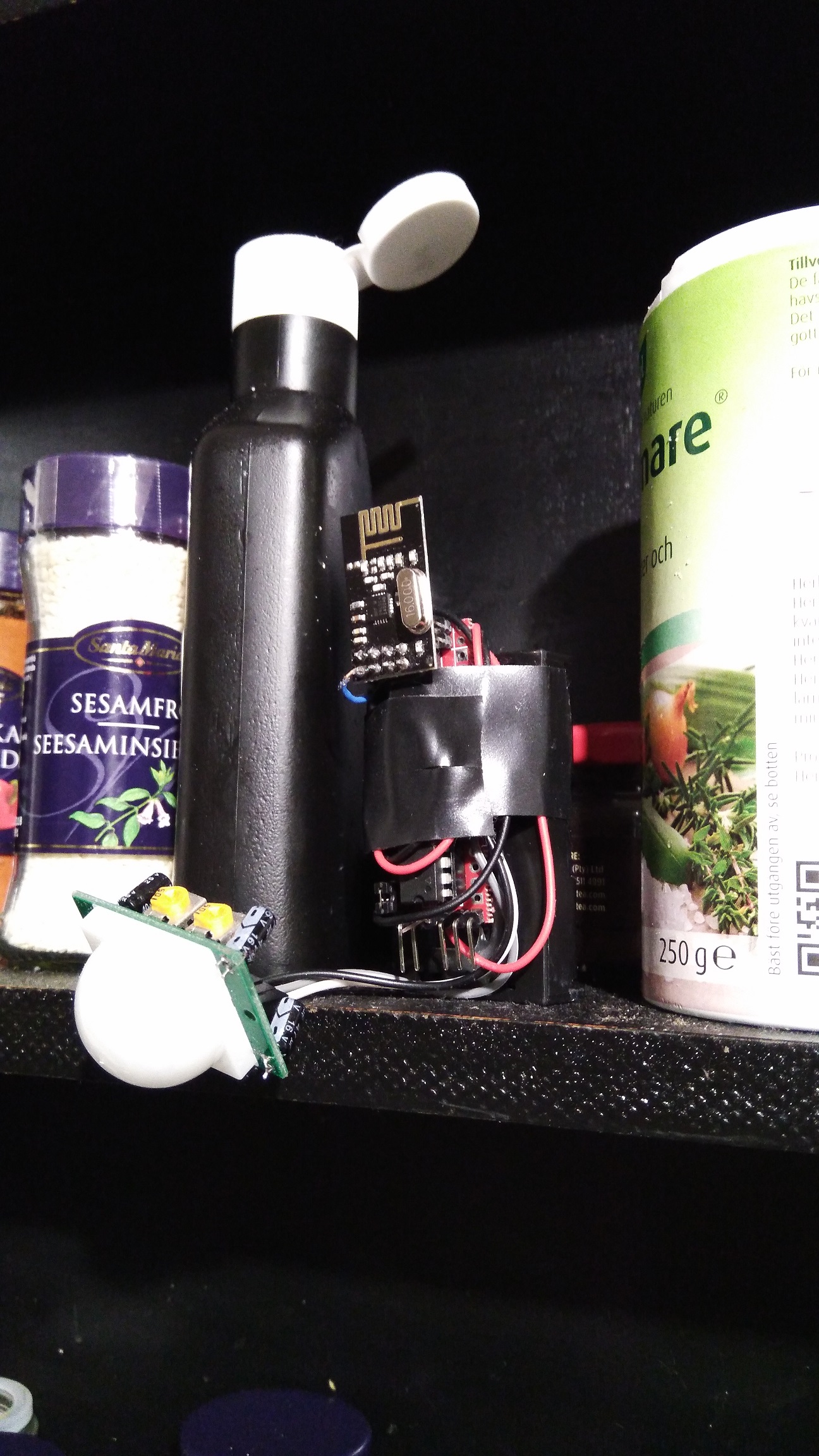What did you build today (Pictures) ?
-
Not working on hardware at the moment, but I am still "building" things with mysensors.. Recently I have been moving all my homeautomation to docker containers, and also moving stuff towards using MQTT as a backbone transport.
Right now I have moved automation rules from domoticz to nodered, after which I have "killed" domoticz (the only reason why I had been keeping it alive, was because it handled some of my automation rules for turning tv / amplifier on when chromecast was active etc).
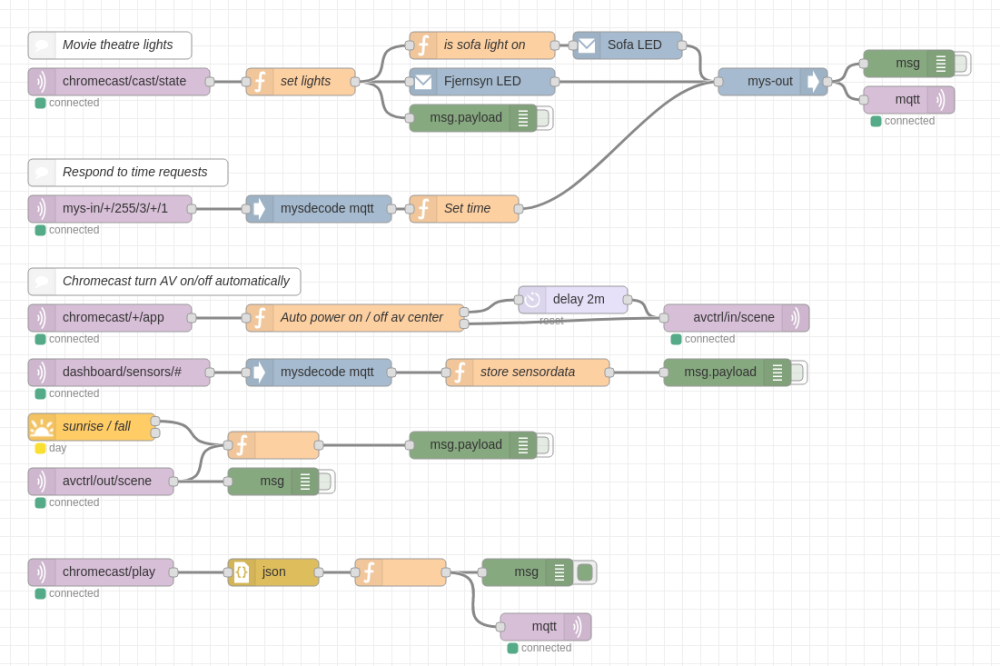
Together with my chromecast "surveilance python service" I get notifications on MQTT when any of my two chromecasts starts an app / pause/ play etc. The python program also has a MQTT listener, so I can send pause/play etc. to my chromecasts over mqtt. And even throw a stream to it over mqtt.
Today I made a universal control endpoint, so I can send pause/play etc. to a single mqtt topic, and then nodered directs it to the active chromecast, or to my dvd player if that is the active in the current scene.
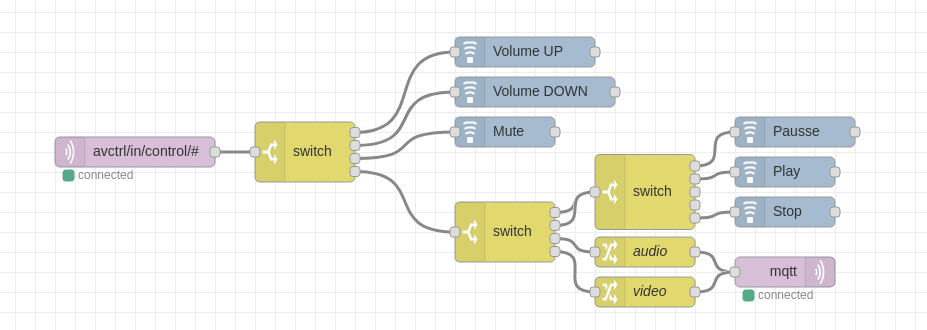
In the end everything should play together with a dashboard that I have made in angular5 (rewriting it at the moment to use MQTT instead of various http calls)
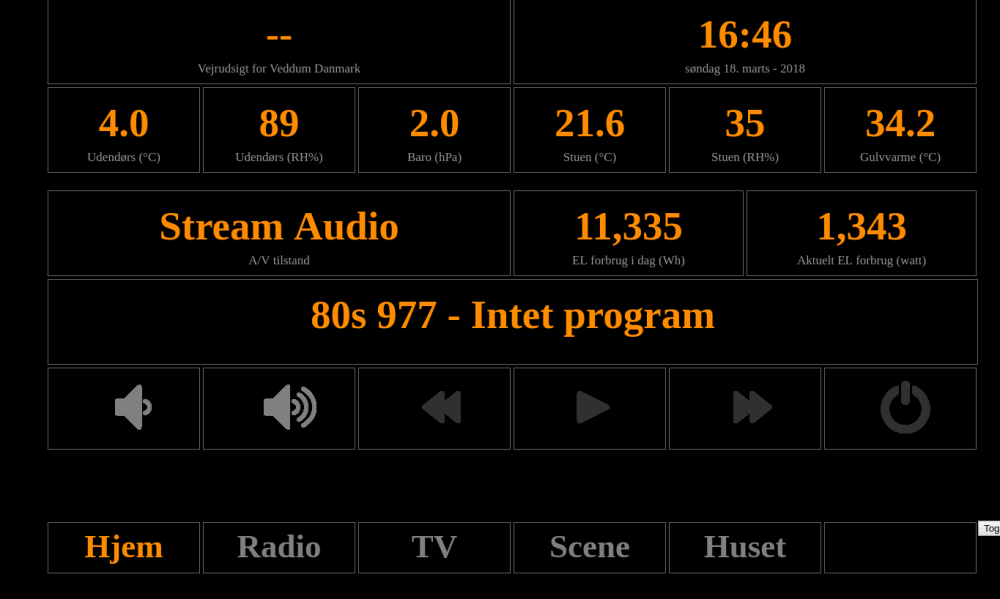
The plan is that the dashboard is on a wallmounted tablet, acting as a simple dashboard / weather station, where one can control basic things in the livingroom (start streaming of specific Radio / TV channels among other things).
The nodered project can be found here, if anyone would like to have a look..
-
I have been using influxdb/grafana for the last year or so, for logging data and presenting it, so no need to use domoticz for that. Over a year ago I injected nodered into the stream, so it sits between mysensors and domoticz, and was used to route things around (And make some fake sensors for domoticz).
For the dashboard part I have been developing my own solution. First it was running within domoticz as a customized dashboard, but I moved it to Angular instead, with a strong dependency towards domoticz, as I could query that to get sensor values. Lately I had moved on to use MQTT for the dashboard (and internal node-red data routing). There I can get persistent data (retain) that keeps the latest data on a given topic. Then my need for domoticz went away there..
The last thing I then used domoticz for, was the automation rules for turning on / off my tv when the chromecast was activated, and control a couple of LED strips according to the state of the chromecast (playing / paused etc). With that moved to nodered, then domoticz could be turned off.
The complete software stack is a bit larger, than with domoticz for everything, but it is much more flexible, than what I could achieve with domoticz.
also it brought in a couple of needed updates for my node-red mysensors nodes, so that was a "bonus" as well :)
-
I have been using influxdb/grafana for the last year or so, for logging data and presenting it, so no need to use domoticz for that. Over a year ago I injected nodered into the stream, so it sits between mysensors and domoticz, and was used to route things around (And make some fake sensors for domoticz).
For the dashboard part I have been developing my own solution. First it was running within domoticz as a customized dashboard, but I moved it to Angular instead, with a strong dependency towards domoticz, as I could query that to get sensor values. Lately I had moved on to use MQTT for the dashboard (and internal node-red data routing). There I can get persistent data (retain) that keeps the latest data on a given topic. Then my need for domoticz went away there..
The last thing I then used domoticz for, was the automation rules for turning on / off my tv when the chromecast was activated, and control a couple of LED strips according to the state of the chromecast (playing / paused etc). With that moved to nodered, then domoticz could be turned off.
The complete software stack is a bit larger, than with domoticz for everything, but it is much more flexible, than what I could achieve with domoticz.
also it brought in a couple of needed updates for my node-red mysensors nodes, so that was a "bonus" as well :)
@tbowmo interesting indeed, tnx for sharing. Currently I still use Domoticz for the API Logging is done with INFLUX and Grafana. However in addition to Domoticz I use Pass2PHP. I can now control everything with PHP. PHP seems pretty common so a lot of examples I can find online ;-0. I am a complete MQTT / NODE-RED NOOB.
-
@tbowmo interesting indeed, tnx for sharing. Currently I still use Domoticz for the API Logging is done with INFLUX and Grafana. However in addition to Domoticz I use Pass2PHP. I can now control everything with PHP. PHP seems pretty common so a lot of examples I can find online ;-0. I am a complete MQTT / NODE-RED NOOB.
-
It is always those last connections...
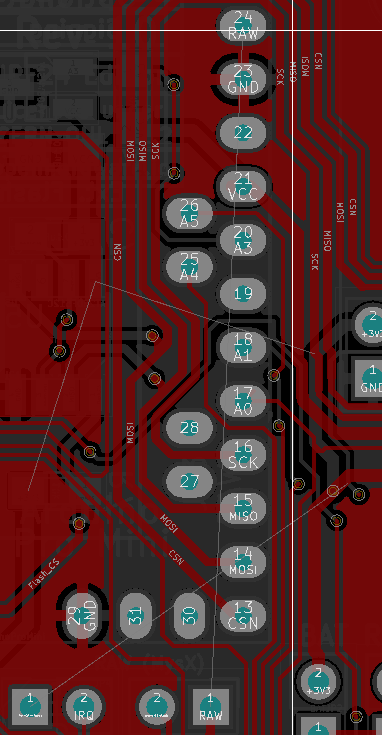
-
@tbowmo interesting indeed, tnx for sharing. Currently I still use Domoticz for the API Logging is done with INFLUX and Grafana. However in addition to Domoticz I use Pass2PHP. I can now control everything with PHP. PHP seems pretty common so a lot of examples I can find online ;-0. I am a complete MQTT / NODE-RED NOOB.
@sincze well you're half way there, already got influxdb implemented :)
NodeRed is pretty easy to work with, and MQTT is (almost) just start and forget with mosquito. Just a messaging channel that you can hook any listener into, like python scripts, angular5 web apps etc.
-
Today I built auto-detection of missing MySensors keywords. The build system will complain if someone adds a new keyword to the Doxygen documentation but forgets to add it to keywords.txt.
This is what the output looks like on the current code base (we're missing a bunch of keywords):
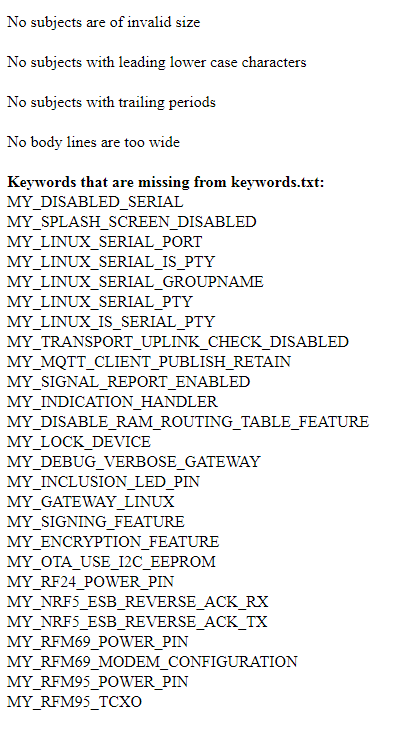
This is the code change:
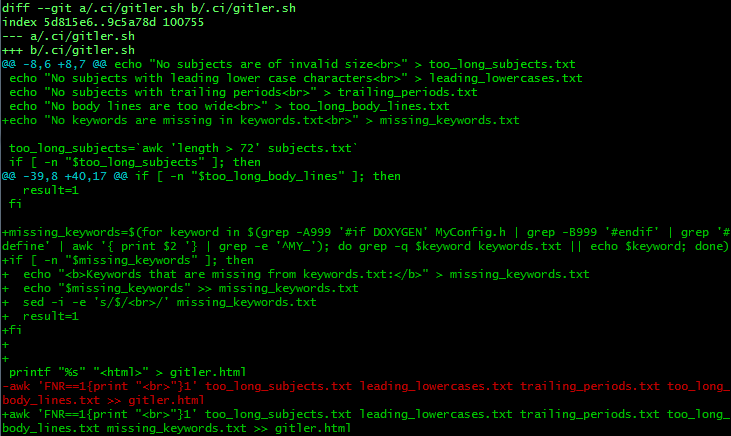
I have also added those missing keywords to keywords.txt, so now they'll be highlighted properly in the Arduino IDE.
Thanks to Anticimex for assisting me in working with the build system.
-
One more build for today: building the raspberry pi gateway.
I often need to test different settings for the Raspberry Pi Gateway. Running make after just changing one parameter in the configure command (for example, turning on or off interrupts for nrf24 or changing the PA_LEVEL) results in a 1m 13s wait on my Raspberry Pi:

I installed ccache using these instructions and now a make with the same type of change is done in 31s.

Not that much of a win, but it saves a lot of time when trying many different settings. -
@mfalkvidd on my Pi3 it takes 40 around seconds, are you using an old Pi1 ?
-
Today I finally got my thumbs out and upgraded my plant monitoring to MySensors 2.x (from 1.x).
Updated sketch is available on Github: https://github.com/mfalkvidd/arduino-plantmoistureResult: I really need to water my plants ;-) But the 2.5 year old batteries are still going strong.

-
Tonight some more PCB design:
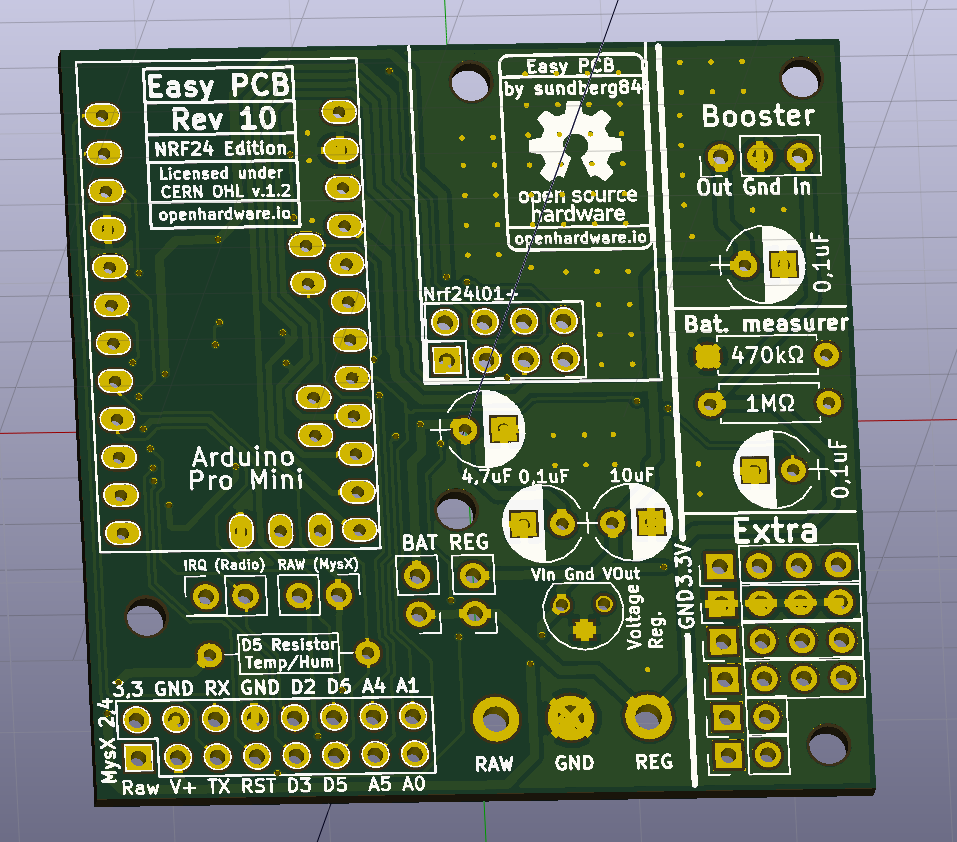
-
Tonight some more PCB design:

@sundberg84 I will throw my two cents in on the design. An issue that I had brought up on previous revisions had to do with capacitors. On the Rev 9 and below boards, your capacitor footprints were pretty much all for flat ceramic capacitors. While I was able to make it work for the couple can style electrolytics that I used, it wasn't quite right. Now on this revision, I see that all of your capacitors have a can electrolytic style footprint. I think it needs to be a mix. The 4.7uf and 10 uf capacitors should be can style footprint, whereas your 0.1s should be non polarized ceramic flat cap footprints. The flat pack ceramics I think have a wider hole spacing.
Again, just my two cents
-
@sundberg84 I will throw my two cents in on the design. An issue that I had brought up on previous revisions had to do with capacitors. On the Rev 9 and below boards, your capacitor footprints were pretty much all for flat ceramic capacitors. While I was able to make it work for the couple can style electrolytics that I used, it wasn't quite right. Now on this revision, I see that all of your capacitors have a can electrolytic style footprint. I think it needs to be a mix. The 4.7uf and 10 uf capacitors should be can style footprint, whereas your 0.1s should be non polarized ceramic flat cap footprints. The flat pack ceramics I think have a wider hole spacing.
Again, just my two cents
@dbemowsk the positive with polarized footprint is that you can use both and it's very easy for a newbie to see which one is Gnd. You who are more experienced can determine if you want to use a flat unpolarized cap.
-
This evening I spent a few hours finding more MySensors keywords that exist but weren't highlighted.
I found about 20 that were documented but not highlighted, so I added them.I also found 3 that weren't documented nor highlighted. I have created issues on github to document them. Help is welcome. Documenting the keywords is an easy way to contribute to the project.
https://github.com/mysensors/MySensors/issues/1090
https://github.com/mysensors/MySensors/issues/1089
https://github.com/mysensors/MySensors/issues/1088 -
@dbemowsk the positive with polarized footprint is that you can use both and it's very easy for a newbie to see which one is Gnd. You who are more experienced can determine if you want to use a flat unpolarized cap.
@sundberg84 one of the 0.1uf caps that i use has short leads and wouldn't fit that hole spacing. They are higher voltage capacitors that i bought years ago for another project that i am trying to use up. I do see your point though.
-
Today I finally got my thumbs out and upgraded my plant monitoring to MySensors 2.x (from 1.x).
Updated sketch is available on Github: https://github.com/mfalkvidd/arduino-plantmoistureResult: I really need to water my plants ;-) But the 2.5 year old batteries are still going strong.

@mfalkvidd said in What did you build today (Pictures) ?:
Today I finally got my thumbs out and upgraded my plant monitoring to MySensors 2.x (from 1.x).
Updated sketch is available on Github: https://github.com/mfalkvidd/arduino-plantmoistureResult: I really need to water my plants ;-) But the 2.5 year old batteries are still going strong.

What kind of components is this running on? I am having trouble getting my batteries to run even 2.5 months (or 2.5 weeks for the outside temp sensor...) :)

